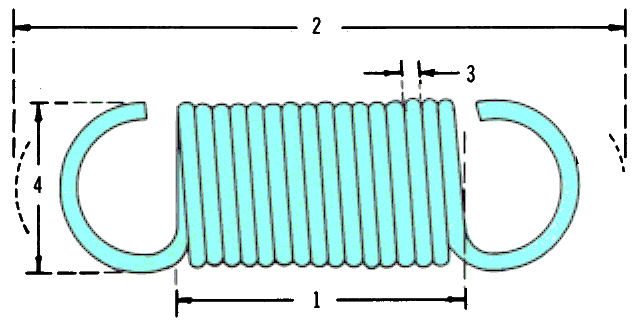Tension Springs
Guide to Tension Springs Specification
A. Wire Diameter.(3)
B. Spring length measured between hooks or loops.
-
Free length.
-
Installed length.(2)
-
Maximum operating length.
-
Length of body or close wound section.(1)
C. Spring Diameter(4)
Usually the outside diameter of the body section is given.
D. Number of Coils
The number of coils on the body secfic is sometimes given, but it is preferable to give the length of the body section.
E. Style of Ends
Many types of spring ends are available. The least expensive is one mode by using extra coils and is the same diameter as the spring body. Spring ends can be full round, single or double, looped to the side or centre or half-round looped to the centre. The ends may be in line, or at right angles to each other or any other position. They may also be extended, swivelled in a coned end or a screwed insert.
F. Loads
Where possible give loads required at specific deflections of the spring, and state tolerances acceptable.
G. Rate
If a rate of load per unit of deflection required, specify the amount, preferably in Newtons per millimeter. The essential difference between compression or tension springs is that tension springs have initial tension coiled into them. This is the resistance to a pulling force as a result of the coils being wound tightly together. This initial tension must be taken into account when measuring loads of springs.
H. Direction of Winding.
Unless specified this will be considers optional.
I. Stress & Fatigue life
If known, specify these requirements, alternatively this information con be computed and supplied on request. Tension springs will be destroyed if extended beyond their elastic limit. Special tension springs using compression springs and drawbars can be designed to over- come this problem.

-
Spring free length
-
Spring length - under load
-
Wire diameter
-
Outside diameter
